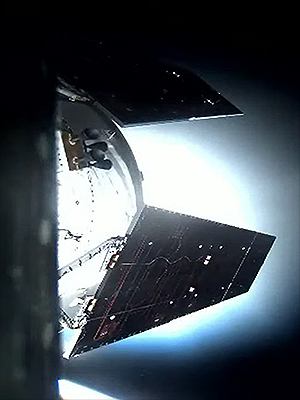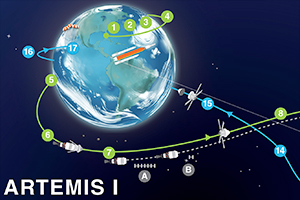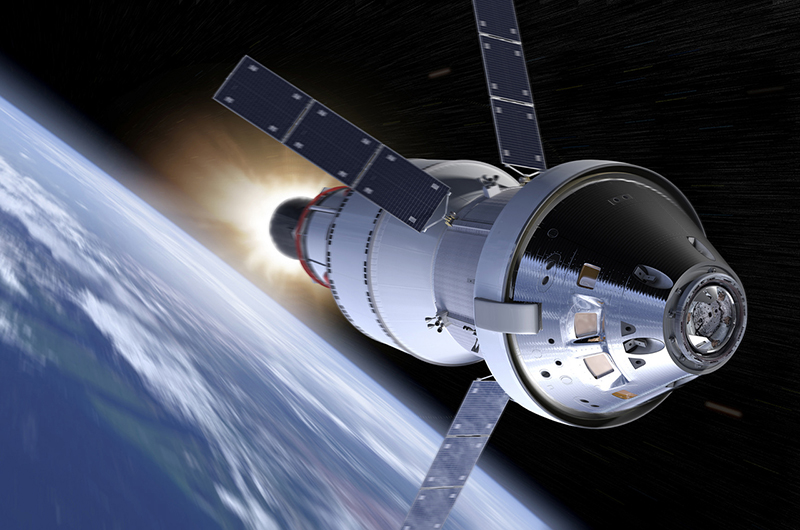 advertisements advertisements
|

|
Artemis away! NASA's Orion spacecraft is moon bound after TLI burn
Artemis I mission coverage presented with the support of

November 16, 2022 — Orion is now bound for the moon.
One hour and 45 minutes after leaving the ground, NASA's Artemis I spacecraft escaped Earth orbit to begin its journey to the moon. The uncrewed Orion is the first vehicle built for astronauts to achieve trans-lunar injection, or TLI, since the Apollo 17 command module almost 50 years ago.
To leave for the moon, the Orion capsule needed to be accelerated fast enough to exceed the pull from Earth's gravity. The Interim Cryogenic Propulsion Stage, or ICPS, which flew as the upper stage of the Space Launch System (SLS) rocket that launched the Artemis I mission earlier Wednesday (Nov. 16), ignited its single RL-10 engine for an 18 minute burn that increased Orion's velocity from 16,840 to 22,670 miles per hour (27,100 to 36,480 kph).
The TLI burn was completed at 3:32 a.m. EST (0832 GMT).
Its purpose now served, the ICPS was set to be jettisoned 10 minutes later. It will fly past the moon and enter a sun-synchronous orbit as its disposal.
Orion will spend the next five days transiting the space between Earth and the moon. About eight hours after TLI, Orion will send back its first video looking at our home planet.
The capsule (and its multitude of cameras) will get its closest look at the moon on Monday, Nov. 21. The result of a fly-by burn by its European-built service module — using an engine first flown on the space shuttle orbiters — Orion will come within 80 nautical miles (0.8 km) of the surface before the moon's gravity directs the spacecraft into a distant retrograde orbit.
On Nov. 26, less than a day into its new orbit, Orion will break the record set by the Apollo 13 mission in 1970, flying beyond 248,655 miles (400,171 km) from Earth, the farthest that a human-rated spacecraft had traveled until now. Ultimately, Orion will reach 298,565 miles (480,494 km, or 40,000 miles [64,000 km] beyond the moon) before beginning its return to Earth.
The primary objective of the Artemis I mission is to demonstrate that Orion can survive a lunar-velocity reentry into the atmosphere. On Dec. 11, 25 days after its launch, Orion will be traveling nearly 25,000 miles per hour (40,000 kph) and experience temperatures up to 5,000 degrees Fahrenheit (2,800 degrees Celsius) as it plunges toward a splashdown. While its heat shield underwent extensive testing on the ground and was demonstrated on a 2014 flight test in high Earth orbit, nothing short of flying to the moon can create the conditions the heat shield will experience at lunar return speeds.
Orion's recovery will pave the way for the next Artemis mission to launch with the first astronauts to fly around the moon in half a century. Artemis II, targeted for 2024, will be followed by a landing at the lunar south pole with the next American and first woman as soon as late 2025. |
|

View of NASA's Artemis I Orion spacecraft during the trans-lunar injection (TLI) burn on Wednesday, Nov. 16, 2022. (NASA TV)

NASA map showing the path that the Artemis I mission will follow out around the moon and back to Earth in 25 days. (NASA) |
collectSPACE is grateful to film and TV company Haviland Digital for supporting our Artemis I coverage. Their team has produced and supported titles such as the award-winning "Last Man on the Moon," "Mission Control: The Unsung Heroes of Apollo" and "Armstrong." |

Rendering of trans-lunar injection (TLI): the Space Launch System's (SLS) Interim Cryogenic Propulsion Stage (ICPS) fires its engine to send NASA's Artemis I Orion spacecraft to the moon. (NASA) |
|

© collectSPACE. All rights reserved.
|
|

|

|
